Faith, Hope and Love (1908)
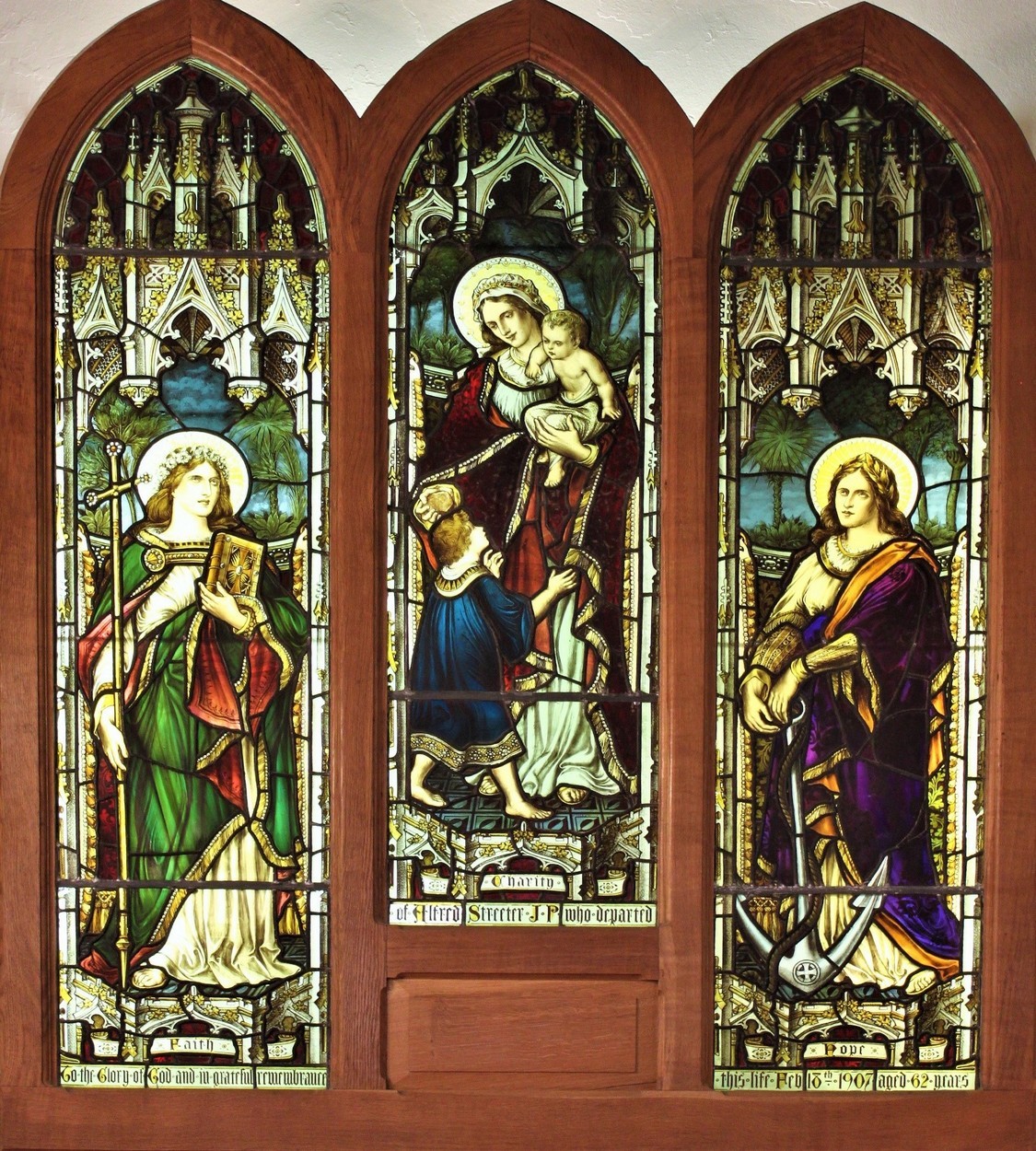
A number of residents of New Malden have made a major contribution to her development. One of these was Alfred Streeter. Alfred was born in Marylebone in 1845, the son of Thomas Streeter, a bootmaker. In December 1867 he was married to Susannah Stroud (1840-1918), the daughter of a florist. The marriage produced three children: Arthur known by his middle name of Herbert (1872-94), Percy (1875-1952) and Florence (1876-1909); all of whom were born whilst the Streeters lived in Rotherhithe.
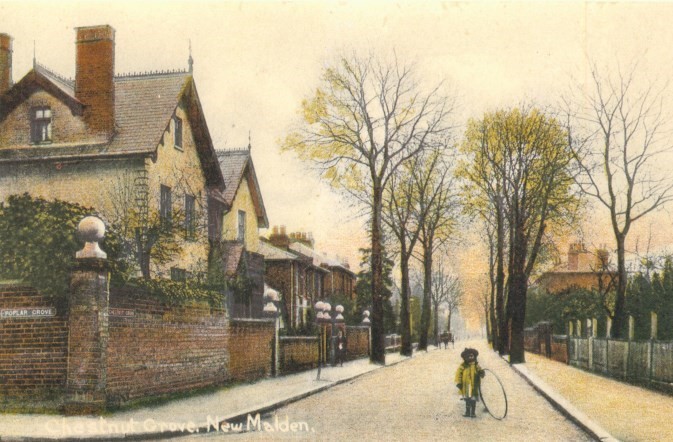
In 1879, the family had moved to New Malden and lived in Fair Cottage in Chestnut Grove. Alfred was a teacher at Malden College, which then stood where Welbeck Close now is.
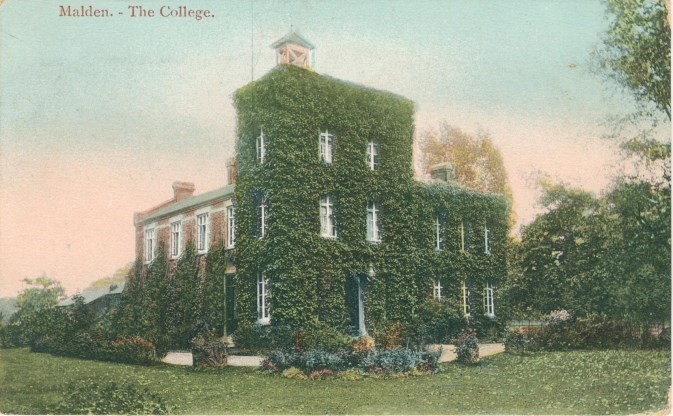
From 1884, Alfred was Proprietor and Headmaster of Malden College and the family lived there with him. The Surrey Comet later described Alfred as ‘not only a skilful teacher but as master of the details of organisation’ and that in his hands Malden College ‘became the most important educational establishment in this part of what was then rural Surrey’. A large proportion of Old and New Malden residents received their education at Malden College and Mr Streeter ‘made himself personally intimate with every boy at the college and was regarded by all of them with the deepest affection’.
In 1885, Alfred Streeter began the first of his two spells as Churchwarden at Christ Church. This lasted for two years until 1887. The first Vicar of Christ Church, the Reverend Charles Stirling, was still in post and the most significant development during that period was the establishment of the ‘Christ Church Mission Room’ (later to become St John’s) on the Kingston Road.
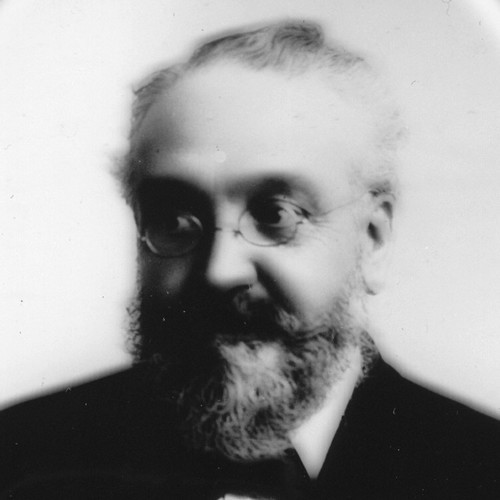
Alfred’s second spell as Churchwarden was from 1892-1895. This period included the resignation of Charles Stirling, the arrival of Christ Church’s second Vicar, the Reverend William Allen Challacombe (1893-1920) and the second enlargement of Christ Church in 1894. Tragically, this period also included the sudden death of his son, Herbert. Herbert’s death at his lodgings in Malden College was witnessed by his father and the doctor attending him was Alfred’s fellow Churchwarden at Christ Church, Dr Edwin Child.
The Streeters along with Herbert’s fiancée Nelly Todd, were devastated by his loss and in 1896 a stained glass window at Christ Church was established in Herbert’s memory. The window depicted Jesus as the Good Shepherd and Light of the World with one side paid for by subscriptions and the other by Alfred Streeter.
By this stage Alfred had stepped down from the role of Churchwarden although he continued to act as one of the Sidesmen at Christ Church. This was a more formal role than now, elected by the congregation, open only to men, and which brought with it ex officio membership of the Parochial Church Council (PCC), when this was first formed at Christ Church in October 1897. With his experience in educational matters, Alfred was also a valued School Manager (governor) at Christ Church School.
Alfred also continued within other key public roles. He was a Justice of the Peace, a keen support of Malden Wanderers Cricket Club and, for around twenty five years, a member of the Local Board and then its successor, the Urban District Council. The Surrey Comet reported that ‘he was invariably to be found on the side of those who advocated the improvement of the district’, even if this alienated some of his fellow higher rate payers. It was in 1900 that Alfred became of Chairman of the District Council, following the death of the previous chairman, Frederick Merryweather.
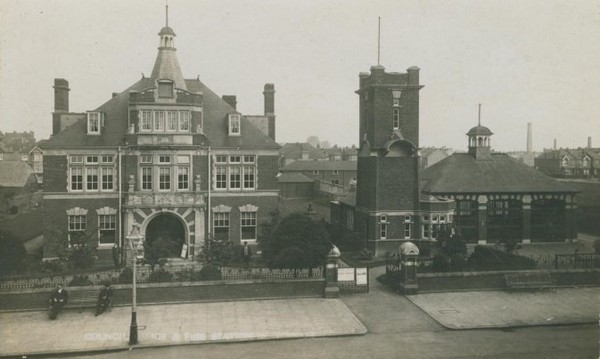
His period of chairmanship was noteworthy for the improvement of drainage, lighting and paving in the district. Perhaps his most outstanding contribution, however, was the establishment of the Council Offices in New Malden alongside stables, a mortuary and a fire station. Alfred Streeter first advanced the idea in May 1903 and the buildings were opened on 27th April 1905.
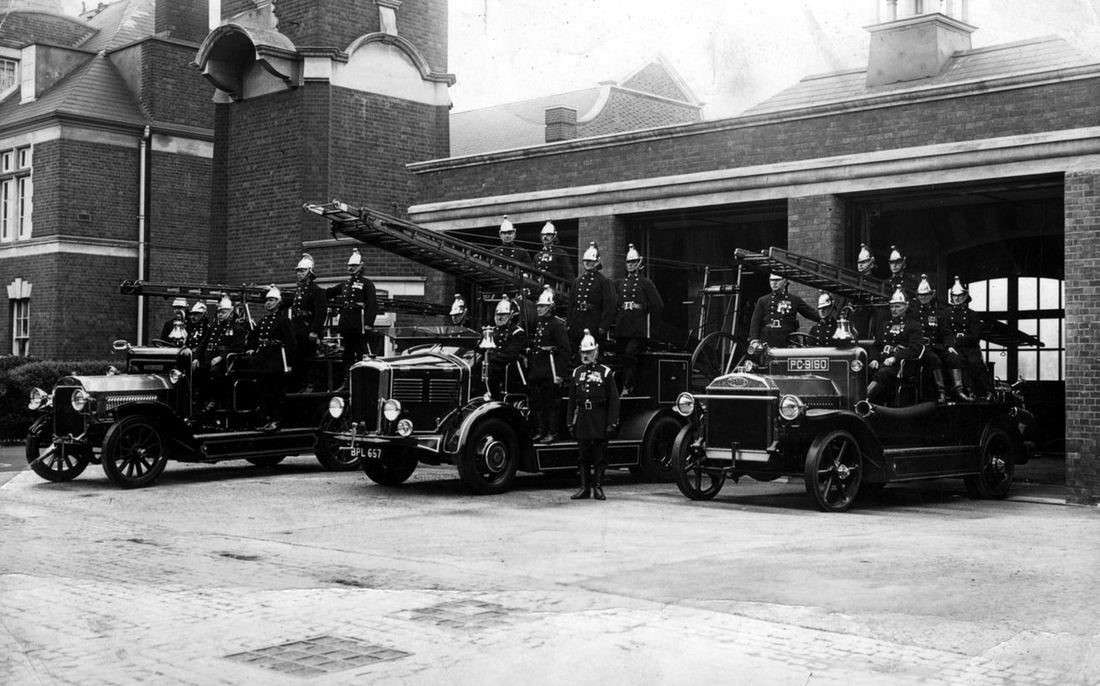
Alfred took a particular interest in the development of the fire service and so much so that New Malden’s first fire engine was named the ‘Alfred Streeter’. The outside of the Council Offices remain today as part of the front of Waitrose!
Alfred Streeter died at the age of 62 on 18th February 1907. Whilst he had been ill, his death clearly came as quite shock to his many friends. The Surrey Comet reported: 'Mr Streeter had been absent from the last few meetings of the District Council but cheery messages were received from him and it was generally hoped and believed that his illness was of a temporary character’. Alfred had undergone a successful operation on the previous Thursday at a private nursing institution in Surbiton but suffered a relapse on the following Monday morning and died at 10.30 am. The tributes to Alfred were immediate with the Surrey Comet giving very full accounts of his contributions to the area and describing him as ‘a most genial gentleman, the soul of courtesy and honour, and held in esteem by all who knew him. He made troops of friends and we doubt if he had a single enemy’.
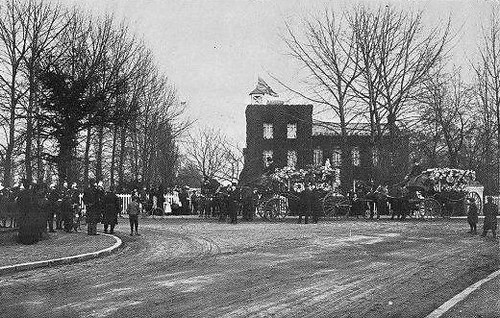
Alfred Streeter’s funeral on 23rd February 1907 was a major event in New Malden. The photo shows its start at Malden College (with its flag at half-mast) before proceeding down the high street towards Christ Church led by the ‘Alfred Streeter’ steamer and pupils from Malden College.
The Surrey Comet reported that it proceeded ‘along a route lined on either side by large crowds of sympathisers’. Once at Christ Church, William Allen Challacombe delivered the address that engaged with widespread grief and of how those indifferent to the responsibilities of human life ‘might learn from the dignity and blessedness of work from the example of their brother’. He commented on Mr Streeter being ‘always ready to see what was good in people and turn a blind eye to their failings and mistakes’ and how his ‘work was now in a higher sphere – in the heavenly mansions of the Father’s home’. Alfred Streeter was then buried at Kingston Cemetery next to his son Arthur Herbert Streeter who had died back in 1894.
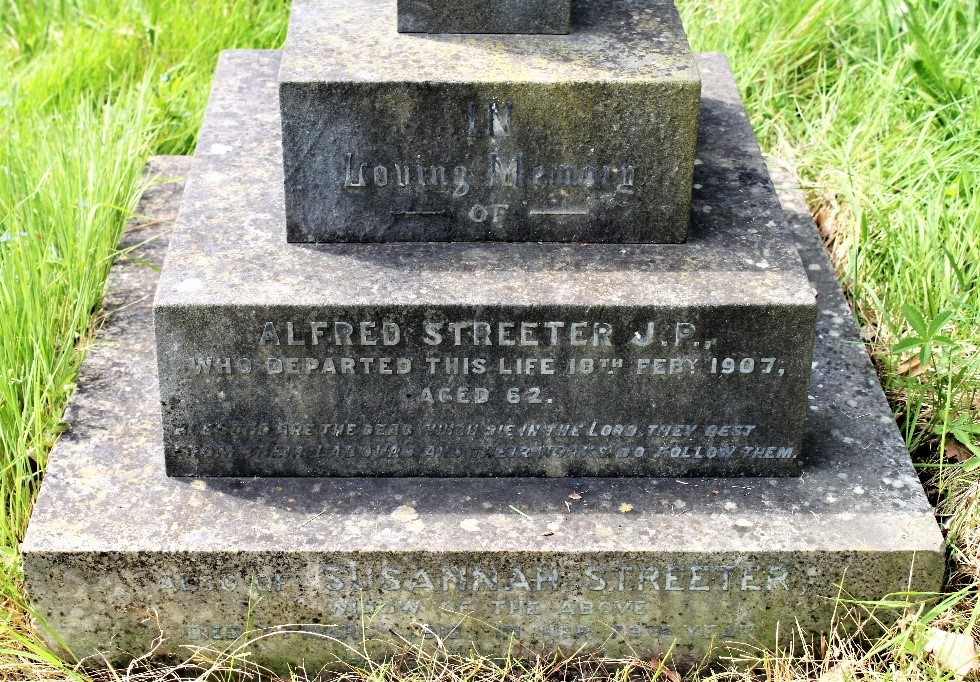
As early as the following month, the idea was formed that Alfred Streeter should be remembered by the establishment at Christ Church of a memorial window. The initial thought was that this would be established alongside that of Herbert Streeter. Subscriptions were sought from members of New Malden and those who contributed to its cost of £75 were then listed in the Surrey Comet. The eventual result was a window designed by Messrs Jones and Willis of London and Liverpool with its subject being ‘Faith, Hope and Love’. Rather than being placed in the south wall, the window was unveiled at the eastern end of the north wall of Christ Church on Saturday 7th March 1908. The window was dedicated by the Bishop of Kingston, Dr Cecil Hook, who spoke on Mr Streeter and the importance of the Christian virtues presented in the window. A public clock in New Malden was the other memorial established in memory of Alfred Streeter.
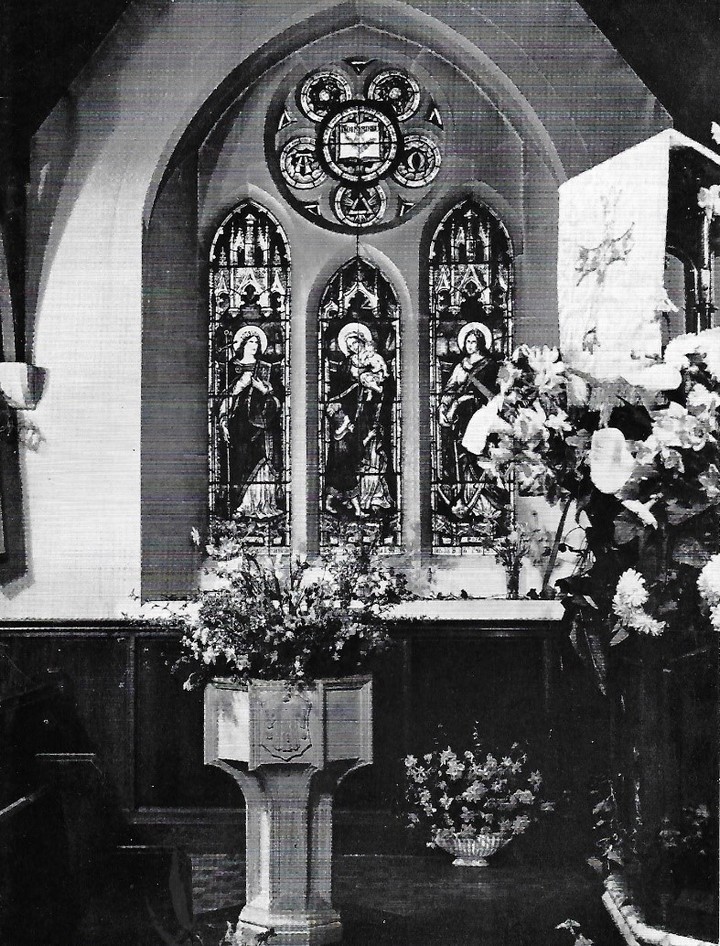
One aspect of the window seemingly uncontroversial at the time was the presence within it of masonic symbols. These appeared within the circular section above those depicting faith, hope and love and alongside cherubs and the Alpha and Omega.
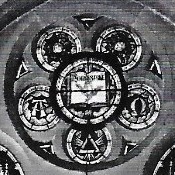
Alfred Streeter was an open Freemason with meetings of the local lodge held at Malden College and a strong masonic presence at his funeral. William Allen Challacombe must have been, at the very least, sympathetic to freemasonry and there are elements of his sermon at Alfred Streeter’s funeral that suggest he may have more than this, particularly when he referred to ‘the gospel of work’ that needed to ‘be preached more earnestly than ever’. At that stage, evangelical Christianity remained largely uncritical in its response to Freemasonry, possibly through a shared aversion to Roman Catholicism. This attitude started to change in the second half of the twentieth century but as late as 1961, the sixth Vicar of Christ Church, Llewellyn Roberts (1958-68) not only allowed but participated in a service at Christ Church to commemorate the Diamond Jubilee of the Malden Lodge.
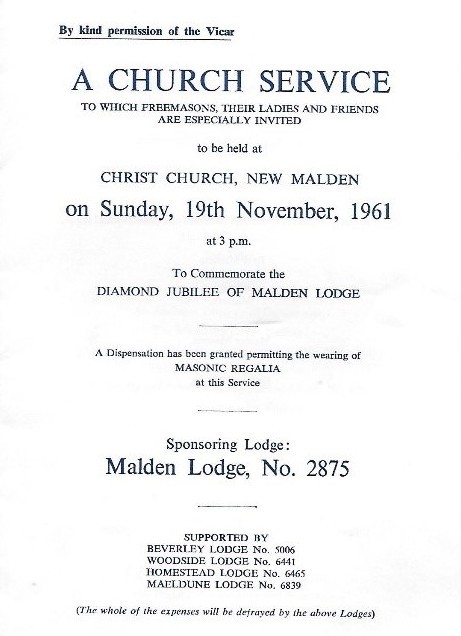
By the 1980’s, however, attitudes towards Freemasonry within the Church of England were overwhelmingly negative, with the General Synod agreeing on its incompatibility with Christianity in 1987. Seven years earlier, in 1980, the construction of the Christ Church Centre entailed the demolition of most of the north wall and the relocation of its stained glass windows to lit boxes on the west wall.
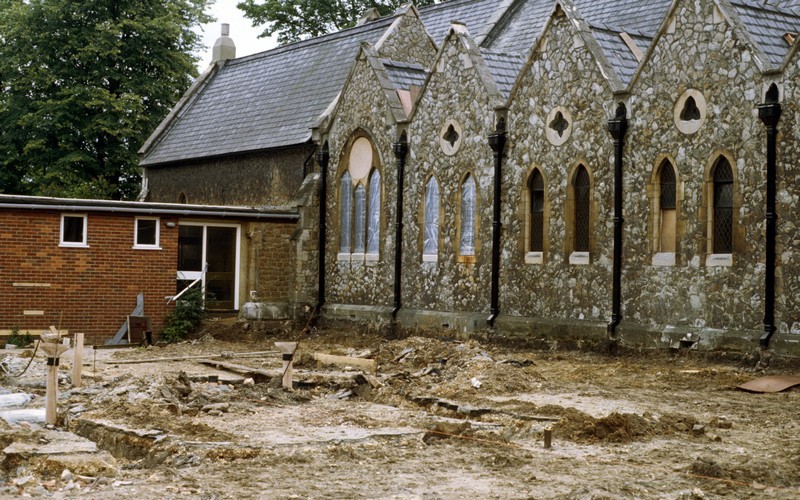
These included the window given in memory of Alfred Streeter, but without the section containing the masonic symbols. John Short, the eighth Vicar of Christ Church (1976-90) was strongly opposed to Freemasonry, and Graham Rushforth, who made the boxes to house the relocated windows, took delight in recounting how he had thrown the offending sections into a skip!
You can listen to the sermon from the Windows on the Gospel sermon series below.
| The Merryweather Window (1902) | Tabitha/Dorcas (1908) |
